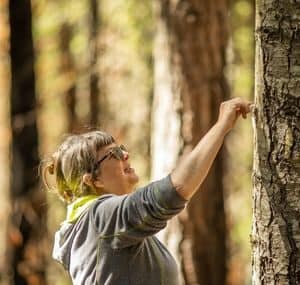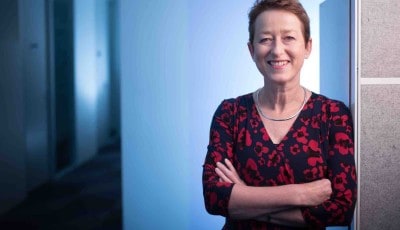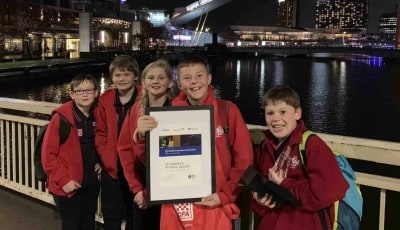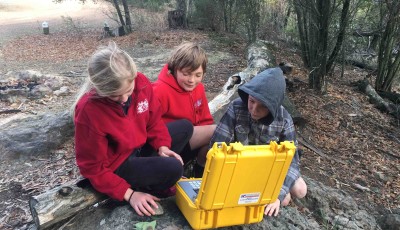A Sense of safety: What young people are capable of in the face of disaster
Children and young people hold a potentially powerful place of leadership within families and communities when it comes to preparedness and recovery from disasters. They are also among the most vulnerable – both in the immediate and ongoing recovery process.
When there aren’t always words to express the enormity of an experience, how can the arts provide a space for sharing stories, building resilience, reducing isolation, giving voice to experience and making sense of the unimaginable?
In this episode of Creative Responders, Scotia Monkivitch visits Strathewen Primary School in rural Victoria to hear from Principal Jane Hayward and a group of Year 6 students about their innovative approach to disaster preparedness following 2009’s Black Saturday bushfires.
We also speak to Professor Lisa Gibbs, the lead researcher of Melbourne University’s ‘Beyond Bushfires’ study, about the importance of fostering leadership, agency and self-determination among children in the face of disaster and Doctor Louise Phillips joins us to explore the role the arts play in leading this evolution.
Interviewees:
Jane Hayward, Principal, Strathewen Primary School
Strathewen Primary School Students: Liam Brereton, Rory Gravette, Scarlett Harrison, Lachlan Seckold, Brodie Donoghue
Lisal O’Brian, Arthurs Creek Strathewen Fire Brigade
Professor Lisa Gibbs, Director of the Jack Brockhoff Child Health and Wellbeing Program at the University of Melbourne. Lead researcher of the Beyond Bushfires study which is providing ongoing insight into how people are managing after the Black Saturday bushfires.
Doctor Louise Phillips, Associate Professor in Education at James Cook University, Singapore who researches in the fields of children’s rights and arts based methodologies and co-author of the new book ‘Young Children’s Community Building in Action: Embodied, Emplaced and Relational Citizenship’
Production Credits:
The series is produced by Scotia Monkivitch and Creative Recovery Network Project Manager Jill Robson, in collaboration with Audiocraft: Executive Producer Jess O’Callaghan, Producer Selena Shannon, Sound Engineer Tiffany Dimmack.
Related links
Survive & Thrive, A Bushfire Message From Strathewan Primary School
Behind the Scenes of the Strathewan Claymation Project (video)
2018 Resilient Australia Award Winners (Emergency Management Victoria)
Beyond Bushfires Study (University of Melbourne)
10 Years Beyond Bushfires (University of Melbourne)
Young Children’s Community Building in Action: Embodied, Emplaced and Relational Citizenship. By Louise Phillips, Jenny Ritchie, Lavina Dynevor, Jared Lambert, Kerryn Mooney
United Nations Convention on the Rights of the Child
Survive and Thrive Program Assessment, University of Melbourne
ELVA: Enhancing Emotional Literacy through Visual Arts, Program Assessment, University of Melbourne
Episode 1 Transcript
[SFX: Driving in, bush sounds, school bell, kids sounds]
SCOTIA: I’m in my car, driving along a winding country road.
I’m only an hour north of Melbourne, but I already feel a million miles away from the city, swallowed up by rolling bushland hills.
I’m in a town called Strathewen on Wurundjeri Country where I’ve come to visit the local Primary School.
[Kids settling in “Spelling test! Oh no…. the dreaded spelling test”]
SCOTIA: Strathewen Primary is a very small school. About 45 students in total. The classrooms are surrounded by tall scraggly gum trees. There’s a chicken coop, and a playground built into the grassy hills. As I walk inside, I think about how the kids in this tight knit community are deeply connected to this beautiful bush.
KIDS: I came when I was five, I am younger than everyone in my grade because I started a year earlier than them. So yeah. It’s different. Strathewen smells nice when it rains. [Teacher:] We’d like some rain…
SCOTIA: The area has been in drought on and off for as long as the town can remember. It’s not always easy living built into bushland like this.
But being part of a tight knit community also brings a sense of security that is unique to small towns. Something to be preserved when the kids move on from their primary school.
JANE: None of our kids go to small high schools. They leave our little hamlet here and head off to be one of fourteen hundred children or whatever.
SCOTIA: This is Jane Hayward, the teaching principal at Strathewen Primary School.
JANE: Well into my 13th year in that role here it’s gone rather quickly. I teach Grade Three Four Five Six, and I have one day in my office…
SCOTIA: Jane takes the responsibility of carrying these children through primary school very seriously.
JANE: Tough things happen. Life. Life is a really bumpy journey. It doesn’t matter how wonderfully things go. Life hits you with some real challenges and I think if we can turn our kids at the end of Grade 6 or as they’ve worked through primary school with the skills to help them navigate and to get safely through the tough bits then they feel capable.
SCOTIA: In Strathewen, getting through the tough bits has become part of the town’s DNA.
JANE: Okay well in 2008 life was pretty normal here. Coming to the end of a 10 year drought 2009 it wasn’t so normal here. Our community and basically all local areas and community were hit hard with the Black Saturday bushfires.
And prior to 2009 we thought we were fairly well equipped to be here and defend the school property and be at home and defend our homes and the rules really went out the window.
We lost our school and the majority of local homes, farms, fences, pets, livestock. You Know the impact was huge and and human loss as well, so we all found ourselves in the thick of something that we could never have imagined.
KIDS: Yeah before Black Saturday, everyone thought “I can stay and protect my house” but now everyone thinks that they would leave. Because so many houses were burnt down and so many people died in that.
KIDS: 27 in our area, in Strathewen died
KIDS: You can replace objects but you can’t replace lives and lost loved ones.
[MUSIC]
SCOTIA: It is becoming increasingly evident that children and young people are carrying the weight of disaster impact in both short term and long term outcomes.
And when you look at the impact of disaster on communities around the world, the role of children and young people in preparedness and recovery is beginning to be addressed as an important issue.
I’m Scotia Monkivitch… and this is Creative Responders, a podcast from the Creative Recovery Network that explores how creativity and the Arts have a unique role to play in disaster management.
In this episode – how do we foster leadership, agency and self determination among children in the face of disaster? What role do the arts play in leading this evolution?
SCOTIA: The Black Saturday bushfires are among Australia’s all-time worst bushfire disasters, with 400 recorded fires burning across the state of Victoria on February 7, 2009.
The impact this had on children and young people has been the topic of much research over the past ten years.
Strathewan was hit significantly by these fires. For this community, the role of their school as a safe haven for children has been under self-examination.
JANE: we were working here with a really impacted community, so our parents my staff myself the kids our incoming students our past students. You know the psychological impact was huge. Nobody felt very safe. We feared the fire season and I say we because it was all of us. You know you’d use a windy night. No one slept.
SCOTIA: And the question came up — how do you talk about fire to children who have lived through, or inherited, fire trauma?
JANE: So we treaded really carefully for a long time. We did stacks of special arts projects healing things. Loads of distractions and highlights because life was so turned upside down and we really needed to look after each other as a community. and we had to handle our things like our fire drills so carefully because these were kids who had sat inside burning homes seen things heard things that children should never ever be part of. We couldn’t really spring surprises too easily on our kids. We used to call them emergency practice here for years. We call it a fire drill now. But for years it was an emergency practice because we couldn’t use the word fire.
LISA: They’re scary for all of us. I mean we all feel anxious if we feel like there might be a bushfire coming.
SCOTIA: This is Professor Lisa Gibbs – she’s the Director of the Jack Brockhoff Child Health and Wellbeing Program at the University of Melbourne.
Professor Gibbs is the lead researcher of the Beyond Bushfires study. It’s providing ongoing insight into how people are managing after Black Saturday and building an understanding of the long-term experiences of those affected by disasters.
Through this work she’s developed a particular interest in the impact of disaster on children and young people.
LISA: One of the strong themes that came out of our research was that loss of safety and stability for children and young people. And it’s probably not surprising because really a fundamental element of childhood is that belief that your parents can keep you safe. And there’s a real comfort in the routines of daily life and both of those things are really seriously undermined after a disaster experience.
SCOTIA: When it comes to building disaster resilience, Lisa believes children need to be involved throughout the total life cycle of emergency management. Especially the very young… who often are overlooked.
LISA: There’s something about assuming that the little ones will forget and that not being quite sure what you do with the little ones. And so I really feel like it’s so important that we think about what about the young ones and and how can we support them in processing what they’ve experienced. Because I can tell you that they do remember and in fact the children who weren’t even born at the time have a narrative around this family experience because they’ve grown up. It’s part of their world.
SFX: bush sounds
KIDS: We have a memorial garden out the back of the school and it has steps up to it and on each step there’s a brick with a name of someone who died in Black Saturday.
SCOTIA: I’ve been chatting to a group of year 6 students at Strathewen Primary.
It’s clear that they are fully aware of the impact Black Saturday had on their community – even though they don’t have living memory of the event.
They have built their own memories of the fire and have been absorbed into a narrative that’s woven into the fabric of their short lives.
KIDS: and down like a kilometre that way, there’s a memorial place and it’s named after Peter Evola which is Mary Evola’s husband. He was found on the cricket pitch.
SCOTIA: In 2009, the people of Strathewen learned a hard truth. There had been an education gap across the whole community regarding fire safety.
JANE: I guess we thought we understood fire. But I look back now and no we didn’t hahaha the knowledge that we have now is very different.
SCOTIA: For Strathewen Principal Jane, something had to be done to equip the kids for the realities of bushfire.
JANE: we’d been so careful about how we managed bushfire education. You know the “do no harm” was the umbrella that we operated under for everything, we didn’t ever want to cause distress to families or kids in our in our care.
SCOTIA: But during this time, researchers like Lisa Gibbs were showing that – actually – kids need to be equipped with knowledge, and that through participating in the emergency management process, their sense of safety increases.
LISA: I think one of the assumptions that we make is that in order to keep children safe, it’s our job to protect them and that they are passive in that exchange and actually one of the things that really increases anxiety if you don’t know if something bad is going to happen again and if it does happen again what are you going to do. How do you manage that.
LISA: it’s about identifying Well what is the competence of young people and how do they make a contribution to their community recovery.
SCOTIA: That’s when Liesel O’Brian came into the picture.
LIESEL: I’m Liesel O’Brian and I’m a member of the ‘Arthurs Creek Strathewen fire brigade’.
SCOTIA: Liesel is a local fire brigade volunteer and she contacted Jane with an idea for a fire training program aimed at children. One that didn’t shield them from the dangers of fire, but instead used art and science to turn them into fire experts.
JANE: She started to come up with ideas. She’s an ideas girl and that just started this incredible momentum of pulling something together that was different and that really was targeted to where we were at and what we needed, what our kids needed specifically. And I think underpinning all that was the thought that kids with knowledge have some power. You know if kids know things. Nothing is as bad as what kids will imagine if they don’t know.
KIDS: Um we’ve learnt how to use all of these different instruments, like the fine fuels moist meter, the whirling hygrometer, the inclinometer…
SCOTIA: The school is now four years into the program.
KID5: …Uh yeah, and a fire extinguisher and a fire blanket.
Liesel: We run sessions on all sorts of things fire related so we’re looking at why bushfires happen, we’re looking at all the elements that need to be in place for a bushfire to happen. We look at the fire danger rating signs, what they mean. We look at triggers for fire plans, the time to get out, the time not to be here.
SCOTIA: Liesel O’Brian’s program runs through grades five and six. It’s quite technical, and the Strathewen students I speak to have a hugely impressive understanding of fire safety.
K5: So the fine fuels moisture meter, it measures how much moisture is in material and how easy it will burn or how hard it will be to put out. The whirling hygrometer measure the moisture in the air, like the humidity. The inclinometer measures the slope of the land. um and the fire extinguisher, we learnt how we use it safely to put out fires.
JANE: So we set about – a little gently at first – we led into it and they were still that those first cohorts of kids were still seriously impacted by what they’d lived through and we just went for it. The kids drove. They owned our project. They came up with the ideas.
LIESEL: So it’s turning what could have continued to be a fairly big negative into more of a positive. so the kids are working out what subject, what we’re aiming for for this year, which topics they want to use and yeah, here we go again for another year! Haha
SCOTIA: It was essential the kids felt fully equipped to react to a bush fire. But more importantly, the students had to lead the way.
Lisa Gibbs’s research shows that when children have agency within preparedness training it can make a difference in their own recovery which then flows on to their families and broader community.
LISA: we should never underestimate the power of children to influence change because they bring back new knowledge into the home, they bring an enthusiasm with that and they can often overcome the inertia of adults who are just overloaded with everyday responsibilities. So I’d say energy and new knowledge is what they bring to the mix.
SCOTIA: These emergency management skills can be challenging to impart in a child-friendly way. For this reason, art and creativity became essential languages for teaching the kids.
As part of the program the Strathewen students make a claymation film every year, on an important topic of their choosing.
KIDS: Stop motion is something where you take a picture of something, then whatever you took the picture of you move that a little bit and then keep going in that process and eventually it’ll make a moving picture.
Last year, it was a walk through Strathewen’s fire history.
KIDS: So um. We decided what we were going to do. Then we drew it out on pieces of paper, what scenes they were going to be, then we made those characters that we needed. Then Jimmy, our film guy who does it with us, he teaches us how to do stop motion and how to move the characters and what buttons to press for each slide.
KIDS: All of us had a go at making the characters for the film so yeah it was shared around everyone.
JANE: I think so much learning can happen through the arts. well-being and the arts walk hand-in-hand. having an avenue of expression is just wonderful and and through our bushfire project you know the kids are crafting and creating something that just grows. They see that all these little components like with our claymation claymation is time consuming. It’s hard work. They start has the roughest idea in town and then it just they add to it there’s layer after layer goes into that you know the prop building the figures making the little armatures there’s the tools are all out there they’re using electronic drills and tools and there’s sanding things and there and it may be a bit horrifying to some but they just bring these incredible parts together to create an end product. And much as we don’t focus on the end product being the be all and end all at all. It’s the process. The process of the learning the process of the relationships the connections the links to community the feeling of belonging, there’s all of those things happen but boy are they proud of what comes through as a finished product. They just love it.
LOUISE: It’s the process. It’s the doing. It’s not about creating an end product. So to let that go.
SCOTIA: This is Louise Phillips, an academic who researches in the fields of children’s rights and arts based methodologies. She’s an Associate Professor in Education at James Cook University in Singapore.
LOUISE: To feel, to sense, to make. And then you’re using your hands, and various parts of your body or all of it if you know your dancing. So. Because trauma does sit in your body. So the arts can give that expression to release. And yeah, to make meaning as well, what’s going on.
SCOTIA: Louise’s work is important in that it confirms the ways in which the arts can give voice to young people – providing multiple modes of expression for their emotional and intellectual experience.
LOUISE: I think we do in education and in the West generally have a strong emphasis on the word but that’s not our only communicative tool. And particularly children will express you know we as adults have had twelve years of conditioning of schooling which emphasizes the word but young children will express themselves in so many different ways. And the arts really welcome that space and see that space and that’s what they do they are a forum for that. Yeah.
LOUISE: It might be in even simple subtle ways that the children want to express. And if through being heard you know this is what we all need is to be seen and heard and validated. And that can just give you a tremendous boost and strength to go on.
SCOTIA: As with the Strathewen claymation project, the participatory process is more important than the outcome. The project engages a whole of community approach where the children lead the senior members of the community in an inter-generational creative learning process.
There’s a growing use of the arts in post disaster recovery to provide a space for sharing stories, connecting, reducing isolation, giving voice to experience, making sense of the unimaginable and generating creative engagement, all essential for recovery.
It’s the arts which provides the container for this collective recovery journey.
LOUISE: it’s really about being there to listen and hear is what’s key. So there will be things that will come up for the children that we need to hear and just hold not be there don’t not to feel that you have to have the answers. What’s really key is holding the space.
SCOTIA: I mean additionally to being seen and heard, you talk about young people as being knowledge holders. Can you explain a little what you mean by that?
LOUISE: So we do need to recognize this that we all hold knowledge so we come in to connect as equals. And so this is yet this shift in where the idea of children as social actors. So it’s flattening the hierarchy. And your children will have knowledge from their lived experiences, their own you know cultural backgrounds, their own coming to know and theorizing in a space as well. So you know in the disaster space you know they will be developing their own theories of what’s going on. And even from a very young age you know they’re theorisers.
SCOTIA: Louise I’m interested in you to describe this context of children’s citizenship that you talk about under the ideas or theories that have developed in that over the last few years.
LOUISE: Yeah. So children have. Yeah. Only really recently being recognized as citizens. Of course you know they’re recognize in terms of nationhood citizenship you know by birthright or you know through migration but that’s umm in terms of the actual act of citizenship to be included as participatory members in society is a relatively new concept. So probably in the last couple of decades in that the United Nations Convention on the Rights of the child is a key catalyst in that space along with some schools of thought such as the sociology of childhood where you have repositioned and re-imaged young children all children as social actors who are competent and capable in the here and now rather than what has been in the broader space.
KIDS: On Monday nights my brother Alex, he does volunteer CFA in Kinglake West
K2: It is the Country Fire Authority
KIDS: and I am probably starting that next term. So like every Monday night I say like what did you do? and he like goes out on the trucks and learns how to use the pumps to pump water from the creek or something. So when I’m going to highschool, I want to continue my learning for the CFA so I don’t just like stop after 2 years and forget about it. I want to keep on going.
SCOTIA: It’s clear the program has connected with the kids. The Strathewen project and many others like it have allowed children to grow and be nurtured through what is a deeply impactful experience.
When it comes to preparedness and recovery from disasters, children and young people hold a potentially powerful place of leadership within families, communities and schools.
They are also one of the most vulnerable both in the immediate and ongoing recovery process.
Leaders and activists within impacted communities acknowledge more and more that fostering engaged citizenship in children is a way to build a strong foundation for resilient communities, establishing a greater sense of safety and well-being among its young people.
Cementing the arts as a vital learning tool in a community’s emergency management preparedness strategies will provide safe spaces for sharing, leadership, targeted recovery support and assurance that the needs and contribution of children and young people are valued.
JANE: One of our girls was a very reserved Delightful Delightful girl but very reserved would always prefer to take a back seat. And you know she finished school with us you know very involved in our program and things. And so this girl was sitting in her class and the fire alarm went off at high school in her session and nobody moved. So here’s the alarm sounding and nobody’s going anywhere. So she went up and spoke to her class teacher and said “Oh. Shouldn’t we be doing something shouldn’t you grab the role shouldn’t we be lining up. Isn’t that what we do.” And their class teacher said not now someone sit back down someone will come and tell us what to do so she went back to her seat and the alarm kept going. And she thought no. So she went back up again it’s shouldn’t we be lining up. That’s the alarm. You know we need to you need to line us up. You need to check that we’re all here. You need to take us out to the meeting point with that we’re meant to be. And she was absolutely horrified that the thought that you sat back that an adult would think or that anyone would think that you sat back to wait to be told what to do. That reliance on a rescue coming and our kids are way beyond that. That’s a very old mindset that someone will always come and save you because it’s not the reality.
KIDS: So what we have here is something that lots of people don’t even get to experience and learn throughout their life. So we think this is like a really good experience especially because we are in a high risk bushfire area and we’re really happy to be doing it and it’s really a once in a lifetime experience.
SCOTIA: Creative Responders is an initiative of the Creative Recovery Network hosted by me, Scotia Monkivitch.
The series is produced in collaboration with Audiocraft, with Executive Producer Jess O’Callaghan, producer Selena Shannon and Creative Recovery Network project manager Jill Robson.
The Sound Engineer is Tiffany Dimmack and Consulting Producer is Boe Spearim.
Original music was composed by Mikey Squire.
If you are interested in supporting your community in challenging times, we would love you to join us by becoming a member of the Creative Recovery Network. You can sign up on our website.
You could also connect with us on facebook, or follow us on twitter and instagram.
We’d love you to tell your friends and colleagues about the podcast – you can find it in all the podcast apps and you can also listen at our website – just go to Creative Recovery dot net dot au forward slash podcast. This is where you’ll also find links and resources for further reading about what we’ve covered in this episode.
The Creative Recovery Network is assisted by the Australian Government through the Australia Council, its arts funding and advisory body.
Thanks for listening.
CODA: KIDS4: If you need to evacuate, you need to stay calm, cool and collected. […] say ‘its going to be alright. I’m getting out of the area, I know I’m going to be safe,’ with like my family and everything where I need.
How to Listen
You can find Creative Responders on Apple podcasts, Spotify, Google Podcasts or your favourite podcast app. You can also listen to all of our episodes right here on our website and access transcripts and resources related to each episode.
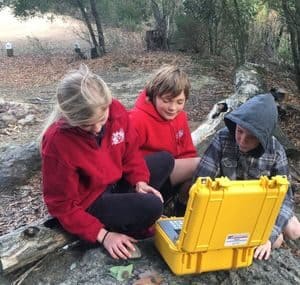
Case study library
